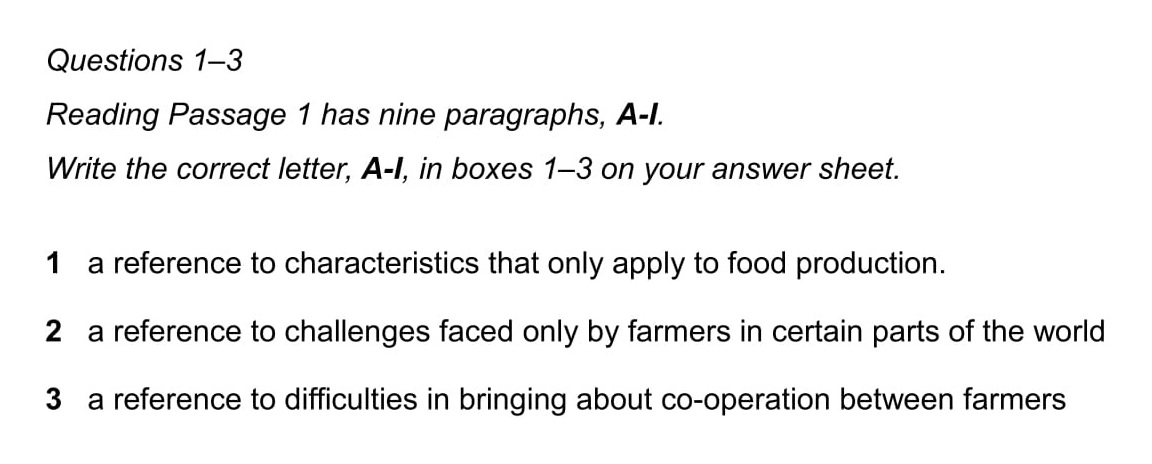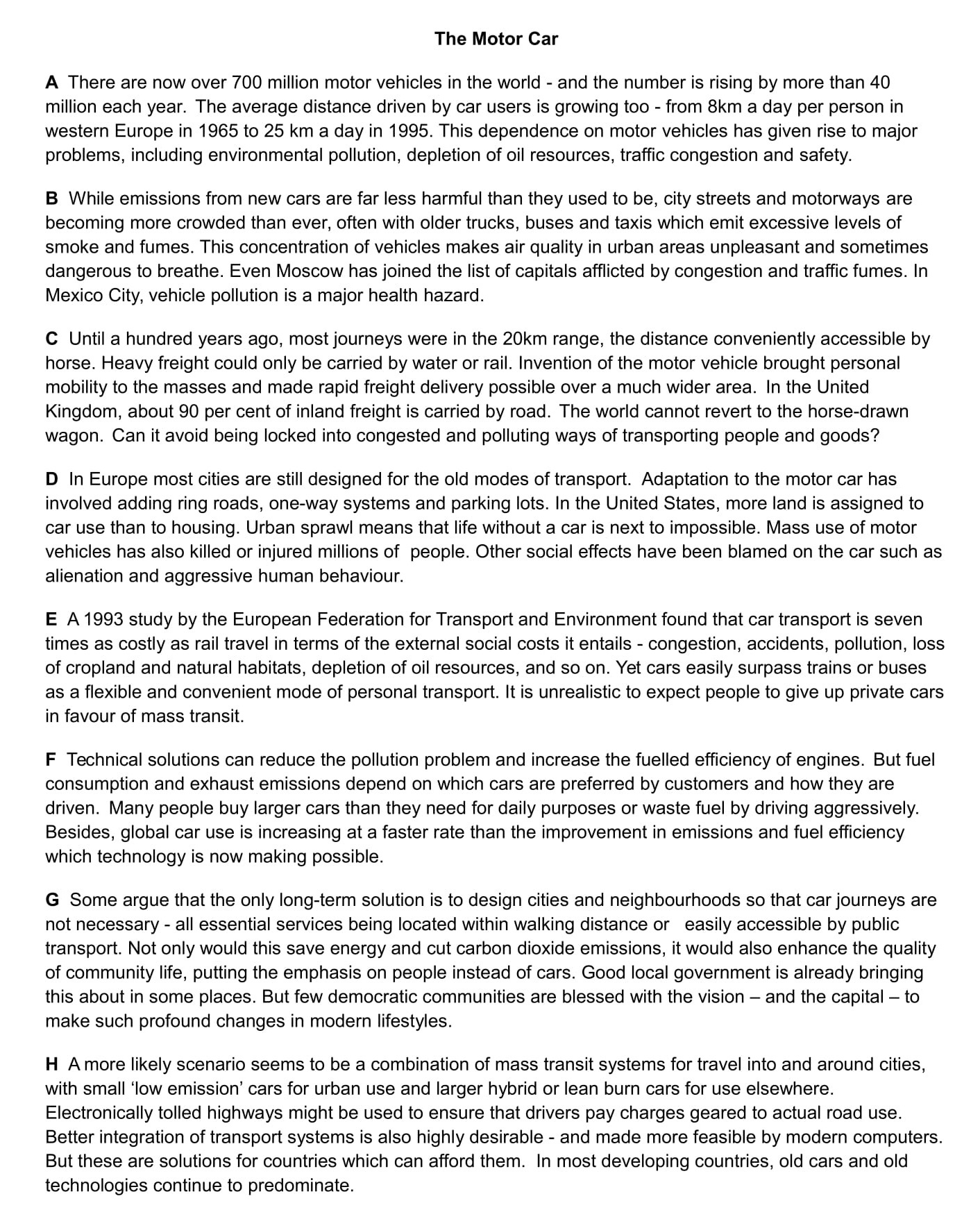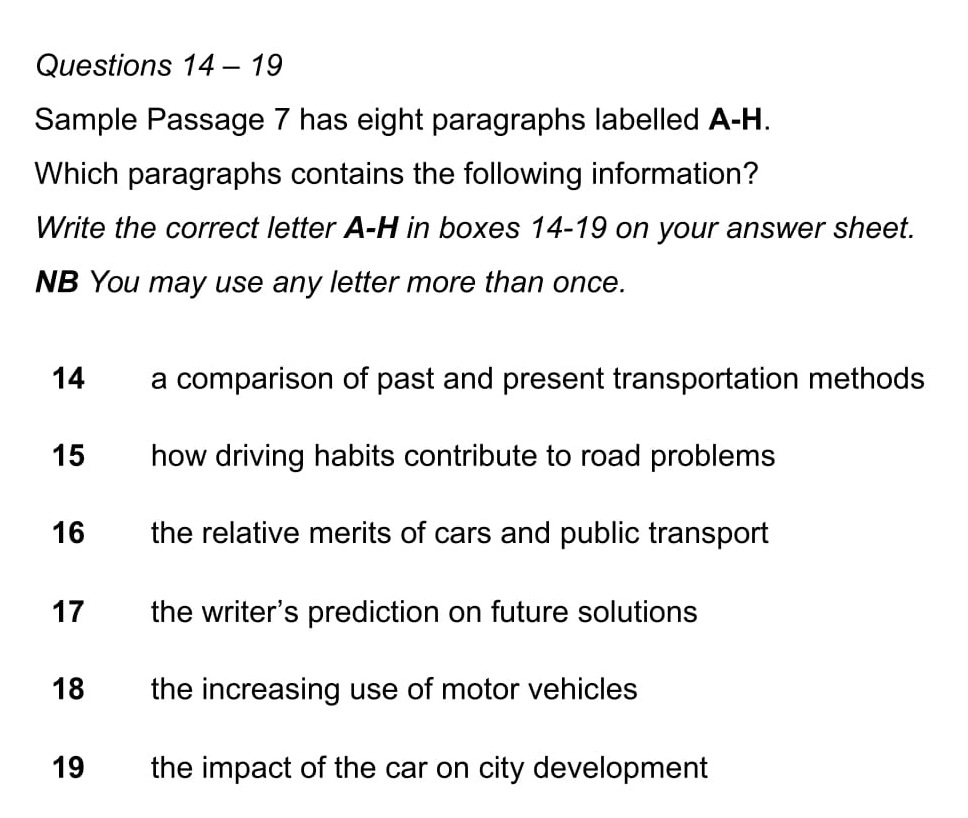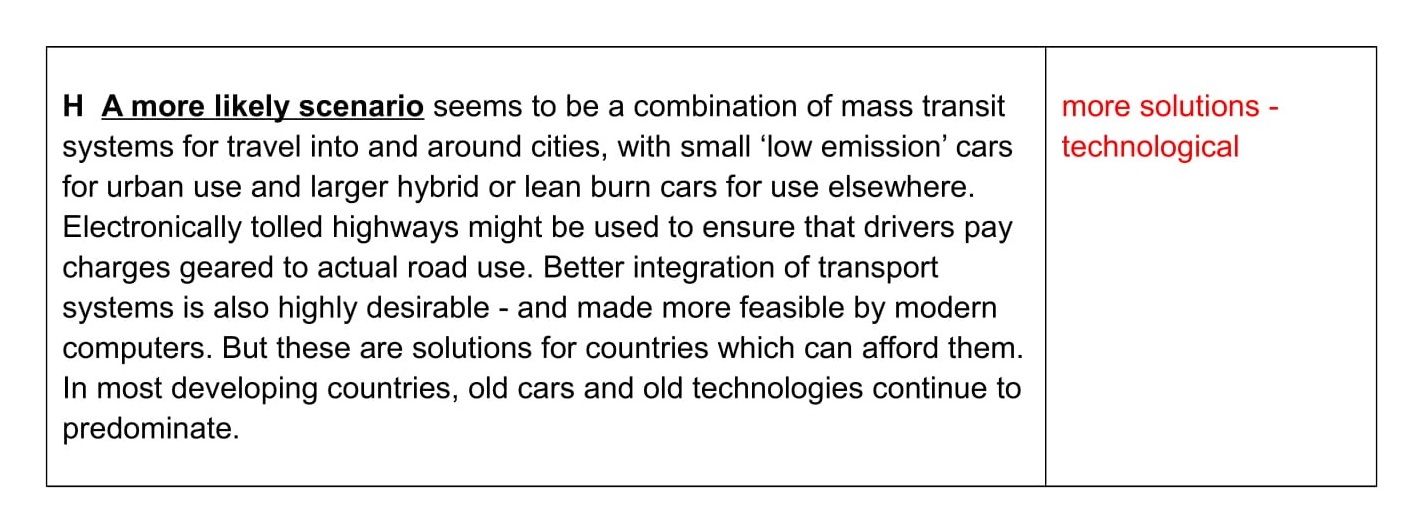IELTS Reading
Matching Paragraph Information
Matching
paragraph information questions are another type of question that comes up
regularly in the IELTS Reading test. Unless you have a good strategy for tackling
this kind of task, you can easily lose a lot of time on it.
The information on this page will help you to be well prepared for exam day. Here’s what it covers:
- Explanation of this question type
- Skills needed
- Key tips
- The strategy
- Examples from real test papers
Explanation of this question type
- You will be given a set of 3 to 6 statements.
- You are required to match the information in each statement to matching
information in a paragraph in the reading text.
The type of information included in the statements can vary widely. You could, for example, be asked to match:
- facts
- descriptions
- opinions
- predictions
- definitions
- explanations
- reasons
- challenges
Here’s an example of instructions and statements taken from a past test paper.

Source: Cambridge English Past Test Paper
Skills needed
This type of question tests your ability to:
- Skim read for general meaning
- Scan for specific information
- Read in detail to find answers
- Identify synonyms & paraphrasing
Matching information questions are a real test of your paraphrasing skills as the information will be expressed in different ways in the statements and in the text. Many synonyms will be used and sentence structures often altered.
Key tips
1) The answers will not come in the same order in the text
as the order of the list of statements.
2) Some paragraphs may not contain an answer.
3) A paragraph could contain more than one answer.
4) The answer will not necessarily be in the main idea of a paragraph as in ‘matching headings’ questions. In ‘matching information’ questions, you will be looking for specific information. Some students confuse these two types of question so be sure that you know which you are answering.
5) Do the other questions on this text first.
Each text will have several types of questions attached to it. If you do the matching information question last, you will have a good understanding of the passage by the time you get to it. This will make it easier and quicker to complete.
6) Expect lots of synonyms. Be particularly aware of information that can be represented in words and figures. For example,
½ – a half
15º – fifteen degrees
69% – sixty-nine per cent
7) Usually, you’ll find the matching information in a phrase or whole sentence, not in an individual word.
8) Search for the easiest information to match first. This will usually be in a statement that contains key words that are easy to find in the text such as names, numbers, places and dates.
This way, if time runs short and you’re forced to move on before completing the question, you’ll at least have picked up the easiest marks rather than wasting lots of time on a difficult question.
9) You can narrow down the match of statement and paragraph by a process of elimination. For any specific statement, there will be paragraphs that are clearly not a match.
The Strategy
I’ll show you how to apply this strategy in the example below but first, you need to understand it.
# 1 Carefully read the instructions.
# 2 Read the statements before you read the text. Take note of the main idea of each statement and think about possible synonyms that might be used in the passage.
# 3 Skim read the text to get a general understanding of what it’s about.
It will help you if you quickly identify the main idea of each paragraph and note it in a couple of words beside the paragraph.
Although the main ideas may not be the information you need to match, doing this will make it quicker to find relevant paragraphs again.
# 4 Return to the statements. Read them again and decide which one you think will be the easiest to match. Since the answers won’t come in the same order as the order of the list of statements, it doesn’t matter which you do first.
These criteria may help determine which statements might be the easiest ones to match.
- There are names, numbers, places and dates that will be easy to scan for.
- There are other key words that should be easy to spot in the text.
- Notes you made beside a paragraph of its main idea match information in one of the statements.
I give detailed explanations on this step of the strategy in the sample test below.
# 5 Once you’ve selected your statement, scan the text for key words. When you think you’ve identified the paragraph with matching information, read it in detail to check if you’re right.
Expect synonyms and paraphrasing to be used.
# 6 If you are right and can confirm the match, fill in the answer sheet and cross through the statement to eliminate it from further consideration.
If you’re wrong, continue scanning for the correct paragraph.
# 7 Repeat this process until you have matched all the statements to paragraphs.
Example with answers
This example
comes from the official IELTS website, www.ielts.org. Before checking the
answers, I strongly recommend that you see if you can match the statements to
the right paragraph following the steps in the strategy.
If you find this really challenging, go straight to my notes below on how I completed this sample test as I include lots more information on answering this type of IELTS Reading question than I could cover in the basic strategy.


Source: Official IELTS website ielts.org - Matching Paragraph Information Sample Test
Notes on how I answer the questions
1) I read the six statements to get a general understanding of what they're about.
2) I skim read the text for general meaning and write down a few key words beside any paragraph where it's easy to identify one or more key ideas, e.g.

3) I look at the statements again. There are none with
names, numbers, places or dates that would be easy key words to scan for and
get me off to a quick start, so I can’t use this strategy with this particular
question.
Instead, I read through the statements again looking for information that matches the topic of any of the notes I’ve made beside the paragraphs or matching information that I remember reading in the text.
I’m immediately drawn to the second statement (15) because I remember a paragraph about the choices people make regarding what car they buy and how they drive.
15 how driving habits contribute to road problems
I wrote ‘people’s choices – what car / how drive’ beside the paragraph and this is a close enough idea to ‘driving habits’ for me to think that this could be the right paragraph for a match.

Because of my
notes, I’m able to find the paragraph again quickly and now read it in detail
to see if the information really does match.
I identify the following sentence as containing the information I need:
But fuel consumption and exhaust emissions depend on which cars are preferred by customers and how they are driven.
The information is a good match so I fill in the answer – 15 F.
I then cross through the statement and move on to another one.
4) I decide to try and find a match for sentence 17 next.
17 the writer’s prediction on future solutions
I choose this one because it's about the future so I expect it to come near the end of the passage. It’s a bit of a gamble but one I think it’s worth taking to save time. I can leave it and come back to it later if I can’t find the answer quickly.
I also remember that I wrote notes relating to ‘solutions’ next to two paragraphs (G and H) so this is another strong clue as to where the answer is.
I read paragraphs G and H in more detail. Paragraph G starts, ‘Some argue…’ so it’s about other people’s opinions about possible future solutions. I skim read it to confirm that it doesn’t change to talking about the writer’s opinion part way through. It doesn’t. I move on to paragraph H.
This begins, ‘A more likely scenario…’ This is clearly expressing the writer’s view or prediction about possible solutions. I quickly skim to check that this is the topic of the paragraph. It is, so the answer is 17 H.

5) I choose statement 18 to match next.
18 the increasing use of motor vehicles
I select this one because of the word ‘increasing’. I guess that the text is likely to mention numbers or percentages to give information about the increase in the use of motor vehicles. These should be very easy to spot with a quick scan of the text.
Going back to the text, my eyes are immediately drawn to the first paragraph which contains lots of numbers. I also notice that I’ve noted the words ‘more vehicles’ beside paragraph A which could be a paraphrase of ‘increasing use of motor vehicles’.
I start reading the paragraph in detail and find the information I need for the match in the first sentence. The synonym the ‘number is rising’, which is used instead of ‘increasing’, is another clue that the information matches. I don’t waste time reading any further and mark the answer 18 A.

One of the
challenges with matching information questions in the IELTS Reading test is
that you need to search the whole text for the specific information you need.
Don’t read more than you have to in order to confirm the match of information.
This will only waste time and isn’t necessary.
6) I now have three
statements left to match. I’ve crossed out the ones I’ve already matched as I’ve gone along so it’s easy to see which ones are left to do.
I read the three statements and decide which has a key word that will be easy to find in the text. I choose 16 because I believe it should be easy to spot types of public transport which will lead me to the answer.
16 the relative merits of cars and public transport
I think of some specific types of public transport to scan for. The most likely are ‘bus’ and ‘train’.
I spot ‘bus’ in paragraph B but a quick skim through the text tells me that this section is not about public transport. I continue scanning.
Paragraph E looks more hopeful. It contains several references to types of public transport.

I read the statement again to be sure that I understand what it means. It mentions ‘cars’ as well as public transport and even if I didn’t know what ‘relative merits’ means, I could probably guess that cars and public transport were being compared in some way.
Reading paragraph E in detail, I find a sentence that contains the word ‘cars’ as well as ‘trains’ and ‘buses’ so I’m sure the answer will be here.
Yet cars easily surpass trains or buses as a flexible and convenient mode of personal transport.
The key word
I need to understand in this sentence is ‘surpass’
which means ‘to be better than’. So, cars and types of public transport are
indeed being compared in this sentence.
Again, if you didn’t understand this word, you may still be able to guess the main idea of the sentence from the rest of the vocabulary. However, you can see how important it is to have a good knowledge of synonyms.
I’m confident that I have a correct match of information and mark the answer 16 E.
7) I choose statement 14 to match next.
14 a comparison of past and present transportation methods
This one is easy to match as there is only one paragraph that talks about past forms of transport and I made a note of this when I first skimmed the text.
The answer is thus 14 C.

8) There is now just one statement left to match.
19 the impact of the car on city development
I haven’t written a note beside any of the paragraphs that relate to this statement so I’ll need to scan the whole text for the match.
Although I can’t be sure that it will be in one of the paragraphs I’ve not yet used for an answer, I feel that this is a good place to start.
First I think of possible synonyms of ‘city’ and ‘development’, such as, ‘urban’ and ‘improvement’, then scan paragraphs B, D and G for these.
Paragraph B contains the word ‘city’ but not information about ‘development’. Paragraph D, on the other hand, contains both ‘cities’ and ‘urban’. I can’t see the word ‘development’ or immediately spot any obvious synonyms so I read in more detail to see how the statement might have been paraphrased.

I identify the second sentence as containing the information I’m looking for.
Adaptation to the motor car has involved adding ring roads, one-way systems and parking lots.
This clearly
refers to situations where cars have influenced, or ‘impacted’, development in
cities. The final statement match is, therefore, 19 D.
Answers
14 C
15 F
16 E
17 H
18 A
19 D
Want to watch the video of this page? Click here.
I
hope you’ve found these extra notes helpful. If you work through the strategy
step by step, using any little clue you can find as to the correct statement
and paragraph matches, you have every reason to do well in this type of IELTS
Reading question.
The most important thing to do is to practice. This is the only way to develop your skills and get quicker at answering matching information questions.
Like this page?
Lessons On All Question Types
For more sample questions with step-by-step instructions, see the IELTS Reading menu page.
More Reading Test Pages
IELTS Reading Test – Understand the format, question types & marking system & know what skills are assessed. Also learn success strategies, key reading skills & discover top tips.
IELTS Reading Skills – Master the skills of skimming, scanning & detailed reading. Understand the importance of topic sentences & how to use context for meaning & unfamiliar words.
Top 7 IELTS Reading Tips – Each tip will take you a step closer to the high score you want. They are the key to top marks in your test.
9 More Tips For IELTS Reading – Learn valuable practice techniques & discover a secret that may gain you extra marks.
IELTS Reading Practice – Discover the top 5 things you must do to prepare for your reading test.
How to Complete the IELTS Reading Test in 60 Minutes – Top 6 Recommendations.
IELTS Academic Reading – Why you should take IELTS Academic Reading, test format, text types &
sample tests.
IELTS General Reading – Why you should take IELTS General Reading, test format, text types & sample tests.
Reading Practice Samples – Short activities to improve your reading skills & help you learn topic vocabulary.









